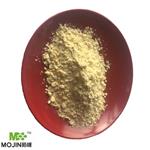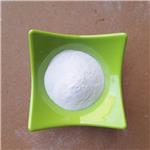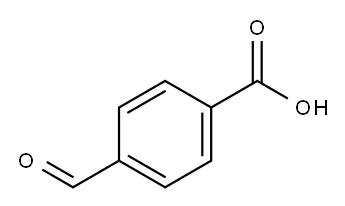4-Formylbenzoic Acid: Versatile Building Block for Biomedical Applications with Catalyst Properties
Dec 28,2023
General Description
4-Formylbenzoic acid is a white crystalline powder used as a building block in the synthesis of pharmaceuticals, dyes, and polymers. It exhibits limited solubility in water but can be dissolved in dimethylformamide and undergoes esterification reactions and alcohol-aldehyde condensation reactions with alcohols. An efficient method for its synthesis involves the aerobic oxidation of aldehydes to carboxylic acids in water, using an inorganic-ligand-supported copper catalyst. This synthesis method is environmentally friendly, avoids the need for expensive and toxic organic ligands, and demonstrates broad substrate tolerance. Furthermore, 4-Formylbenzoic acid has been used as a catalyst in the fabrication of versatile hydrogels with multiple functional properties for advanced biomedical applications, including wound dressings and tissue remodeling.

Figure 1. 4-Formylbenzoic acid
Properties
4-Formylbenzoic acid, also known as 4-Carboxybenzaldehyde, is a white crystalline powder belonging to the class of benzoic acids. It is characterized by the presence of a formyl group at position 4 of the benzoic acid structure. This compound plays a role as a plant metabolite and is classified as a member of benzaldehydes, benzoic acids, and monocarboxylic acids. Its molecular formula is C8H5O3. 4-Formylbenzoic acid exhibits limited solubility in water but can be dissolved in dimethylformamide (DMF). It possesses the ability to undergo esterification reactions and alcohol-aldehyde condensation reactions with alcohols. These properties make it a valuable intermediate for various organic synthesis processes. Due to its chemical structure and reactivity, 4-Formylbenzoic acid finds applications in the production of pharmaceuticals, dyes, and polymers. It serves as a building block in the synthesis of more complex organic compounds. The compound's unique properties, including its role as a metabolite and its versatile reactivity, contribute to its importance in the field of organic chemistry and its relevance in various industries. 1
Synthesis
An efficient method for the synthesis of 4-Formylbenzoic acid can be achieved through the aerobic oxidation of aldehydes to carboxylic acids in water. This method utilizes an inorganic-ligand-supported copper catalyst as the catalyst and atmospheric oxygen as the sole oxidant. Under mild aqueous conditions, a wide range of aldehydes with different functional groups can be successfully converted to their corresponding carboxylic acids. The use of the inorganic-ligand-supported copper catalyst allows for the recycling of the catalyst, maintaining its performance for at least six successive reactions. This synthesis method offers several advantages. It is operationally simple, avoids the need for expensive and toxic organic ligands, and eliminates the use of air/moisture-sensitive and commercially unavailable reagents. The generality of this method suggests its potential for industrial-scale applications. In summary, the synthesis of 4-Formylbenzoic acid can be achieved through an efficient and environmentally friendly aerobic oxidation process using an inorganic-ligand-supported copper catalyst in water. This method demonstrates broad substrate tolerance and has the potential for practical application in large-scale synthesis. 2
Applications as catalyst
4-Formylbenzoic acid has been used as a catalyst in the fabrication of versatile poly(xylitol sebacate)-co-poly(ethylene glycol) (PXS-co-PEG) hydrogels for advanced biomedical applications. The hydrogels based on poly(polyol sebacate) (PPS) polymers are known for their elasticity, biodegradability, and cytocompatibility. However, the limitations of crosslinkers and crosslinking chemistries have hindered the development of PPS-based hydrogels with desired properties. In a study, a new type of PXS-co-PEG hydrogels was fabricated using 4-Formylbenzoic acid as a catalyst along with multifunctional crosslinkers and dynamic bonds. The crosslinking process involved the use of polyethyleneimine-polydopamine (PEI-PDA) macromers, which formed imine bonds and hydrogen bonds with aldehyde-functionalized PXS-co-PEG (APP). This resulted in hydrogels with multiple functional properties, including fluorescence, elastomeric behavior, biodegradability, self-healing ability, bioadhesive properties, antioxidant characteristics, and antibacterial effects. The properties of these hydrogels could be fine-tuned by adjusting the PDA grafting degrees in the PEI-PDA crosslinkers. Importantly, these hydrogels showed great potential as wound dressings, promoting tissue remodeling and preventing bacterial infections in vivo. By expanding the utility of PPS-based hydrogels, the incorporation of 4-Formylbenzoic acid as a catalyst enables the development of multifunctional hydrogels with tailored properties for advanced biomedical applications. 3
Reference
1. 4-Formylbenzoic acid. National Center for Biotechnology Information, 2023, PubChem Compound Summary for CID 12088.
2. Yu H, Ru S, Zhai Y, Dai G, Han S, Wei Y. An Efficient Aerobic Oxidation Protocol of Aldehydes to Carboxylic Acids in Water Catalyzed by an Inorganic-Ligand-Supported Copper Catalyst. ChemCatChem, 2018, 10(6): 1253-1257.
3. Yeh YY, Lin YY, Wang TT, Yeh YJ, Chiu TH, Wang R, Bai MY, Yeh YC. Fabrication of versatile poly(xylitol sebacate)-co-poly(ethylene glycol) hydrogels through multifunctional crosslinkers and dynamic bonds for wound healing. Acta Biomater, 2023, 170: 344-359.
- Related articles
- Related Qustion
- 4-Formylbenzoic acid: Chemical Characteristics, Applications in Medicinal Chemistry and Preparation Method May 10, 2024
4-Formylbenzoic acid, prepared through oxidation of aldehydes, is a stable compound used in antiviral and diabetes drug development due to its role in synthesizing potent inhibitors.
- 4-Formylbenzoic acid: applications and safety Sep 25, 2023
4-Formylbenzoic acid is a versatile compound used in sugar sensing, antibacterial research, and enzymatic studies, requiring careful handling for safety.
- What is 4-Formylbenzoic acid? Jan 19, 2020
4-Formylbenzoic acid is an important intermediate for organic synthesis, widely used in medicine, pesticides, coatings, liquid crystal raw materials, polymer materials and perfume raw materials.
1-Propanol is a good solvent and can be used directly or through the synthesis of propyl acetate in coatings, printing inks, daily chemicals and other fields. It is a polar solvent and can effect other organic systems.....
Dec 28,2023Organic ChemistryGilteritinib, an oral inhibitor of FMS‐like tyrosine kinase 3 (FLT3), is a standard treatment for FLT3‐mutated acute myeloid leukemia.....
Dec 28,2023API4-Formylbenzoic acid
619-66-9You may like
4-Formylbenzoic acid manufacturers
- 4-Formylbenzoic acid
-

- $0.00 / 25KG
- 2023-10-26
- CAS:619-66-9
- Min. Order: 1KG
- Purity: 99%
- Supply Ability: 50000KG/month
- 4-Formylbenzoic acid
-

- $0.00 / 1KG
- 2023-09-06
- CAS:619-66-9
- Min. Order: 1KG
- Purity: 99%
- Supply Ability: 500000kg
- 4-Formylbenzoic acid
-

- $10.70 / 1Kg/Bag
- 2023-03-06
- CAS:619-66-9
- Min. Order: 10g
- Purity: 99%
- Supply Ability: 10000kg




